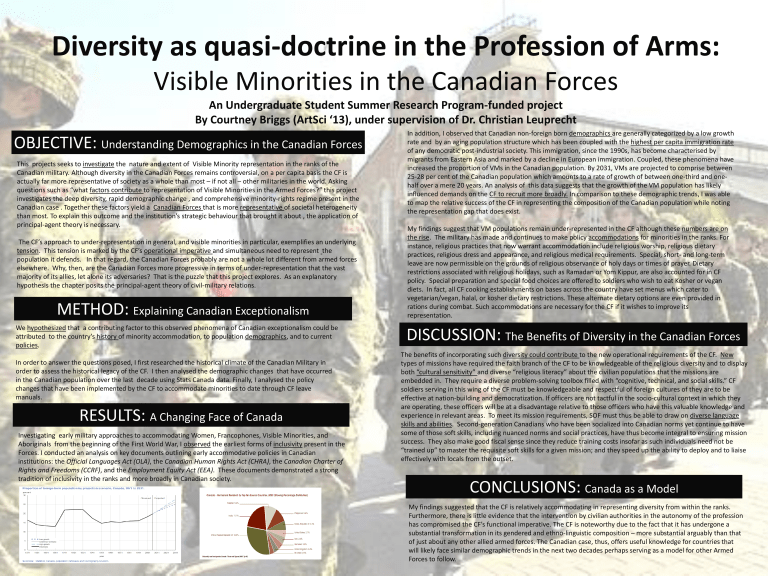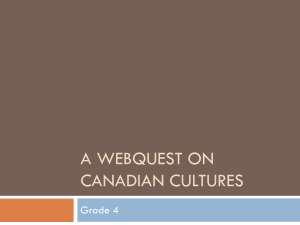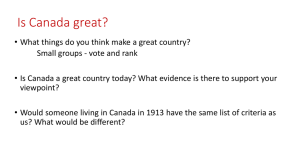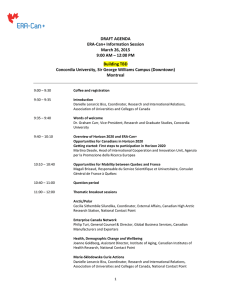Document

.
Diversity as quasi-doctrine in the Profession of Arms:
Visible Minorities in the Canadian Forces
An Undergraduate Student Summer Research Program-funded project
By Courtney Briggs (ArtSci ‘13), under supervision of Dr. Christian Leuprecht
OBJECTIVE:
Understanding Demographics in the Canadian Forces
This projects seeks to investigate the nature and extent of Visible Minority representation in the ranks of the
Canadian military. Although diversity in the Canadian Forces remains controversial, on a per capita basis the CF is actually far more representative of society as a whole than most – if not all – other militaries in the world. Asking questions such as “what factors contribute to representation of Visible Minorities in the Armed Forces?” this project investigates the deep diversity, rapid demographic change , and comprehensive minority-rights regime present in the
Canadian case . Together these factors yield a Canadian Forces that is more representative of societal heterogeneity than most. To explain this outcome and the institution’s strategic behaviour that brought it about , the application of principal-agent theory is necessary.
In addition, I observed that Canadian non-foreign born demographics are generally categorized by a low growth rate and by an aging population structure which has been coupled with the highest per capita immigration rate of any democratic post-industrial society. This immigration, since the 1990s, has become characterised by migrants from Eastern Asia and marked by a decline in European immigration. Coupled, these phenomena have increased the proportion of VMs in the Canadian population. By 2031, VMs are projected to comprise between
25-28 per cent of the Canadian population which amounts to a rate of growth of between one-third and onehalf over a mere 20 years. An analysis of this data suggests that the growth of the VM population has likely influenced demands on the CF to recruit more broadly. In comparison to these demographic trends, I was able to map the relative success of the CF in representing the composition of the Canadian population while noting the representation gap that does exist.
The CF’s approach to under-representation in general, and visible minorities in particular, exemplifies an underlying tension. This tension is marked by the CF’s operational imperative and simultaneous need to represent the population it defends. In that regard, the Canadian Forces probably are not a whole lot different from armed forces elsewhere. Why, then, are the Canadian Forces more progressive in terms of under-representation that the vast majority of its allies, let alone its adversaries? That is the puzzle that this project explores. As an explanatory hypothesis the chapter posits the principal-agent theory of civil-military relations.
METHOD:
Explaining Canadian Exceptionalism
My findings suggest that VM populations remain under-represented in the CF although these numbers are on the rise. The military has made and continues to make policy accommodations for minorities in the ranks. For instance, religious practices that now warrant accommodation include religious worship, religious dietary practices, religious dress and appearance, and religious medical requirements. Special, short- and long-term leave are now permissible on the grounds of religious observance of holy days or times of prayer. Dietary restrictions associated with religious holidays, such as Ramadan or Yom Kippur, are also accounted for in CF policy. Special preparation and special food choices are offered to soldiers who wish to eat Kosher or vegan diets. In fact, all CF cooking establishments on bases across the country have set menus which cater to vegetarian/vegan, halal, or kosher dietary restrictions. These alternate dietary options are even provided in rations during combat. Such accommodations are necessary for the CF if it wishes to improve its representation.
We hypothesized that a contributing factor to this observed phenomena of Canadian exceptionalism could be attributed to the country’s history of minority accommodation, to population demographics, and to current policies.
DISCUSSION:
The Benefits of Diversity in the Canadian Forces
In order to answer the questions posed, I first researched the historical climate of the Canadian Military in order to assess the historical legacy of the CF. I then analysed the demographic changes that have occurred in the Canadian population over the last decade using Stats Canada data. Finally, I analysed the policy changes that have been implemented by the CF to accommodate minorities to date through CF leave manuals.
RESULTS:
A Changing Face of Canada
Investigating early military approaches to accommodating Women, Francophones, Visible Minorities, and
Aboriginals from the beginning of the First World War, I observed the earliest forms of inclusivity present in the
Forces. I conducted an analysis on key documents outlining early accommodative policies in Canadian institutions: the Official Languages Act (OLA), the Canadian Human Rights Act (CHRA), the Canadian Charter of
Rights and Freedoms (CCRF), and the Employment Equity Act (EEA). These documents demonstrated a strong
tradition of inclusivity in the ranks and more broadly in Canadian society.
The benefits of incorporating such diversity could contribute to the new operational requirements of the CF. New types of missions have required the faith branch of the CF to be knowledgeable of the religious diversity and to display both “cultural sensitivity” and diverse “religious literacy” about the civilian populations that the missions are embedded in. They require a diverse problem-solving toolbox filled with “cognitive, technical, and social skills.” CF soldiers serving in this wing of the CF must be knowledgeable and respectful of foreign cultures of they are to be effective at nation-building and democratization. If officers are not tactful in the socio-cultural context in which they are operating, these officers will be at a disadvantage relative to those officers who have this valuable knowledge and experience in relevant areas. To meet its mission requirements, SOF must thus be able to draw on diverse language skills and abilities. Second-generation Canadians who have been socialized into Canadian norms yet continue to have some of those soft skills, including nuanced norms and social practices, have thus become integral to ensuring mission success. They also make good fiscal sense since they reduce training costs insofar as such individuals need not be
“trained up” to master the requisite soft skills for a given mission; and they speed up the ability to deploy and to liaise effectively with locals from the outset.
CONCLUSIONS:
Canada as a Model
My findings suggested that the CF is relatively accommodating in representing diversity from within the ranks.
Furthermore, there is little evidence that the intervention by civilian authorities in the autonomy of the profession has compromised the CF’s functional imperative. The CF is noteworthy due to the fact that it has undergone a substantial transformation in its gendered and ethno-linguistic composition – more substantial arguably than that of just about any other allied armed forces. The Canadian case, thus, offers useful knowledge for countries that will likely face similar demographic trends in the next two decades perhaps serving as a model for other Armed
Forces to follow.





